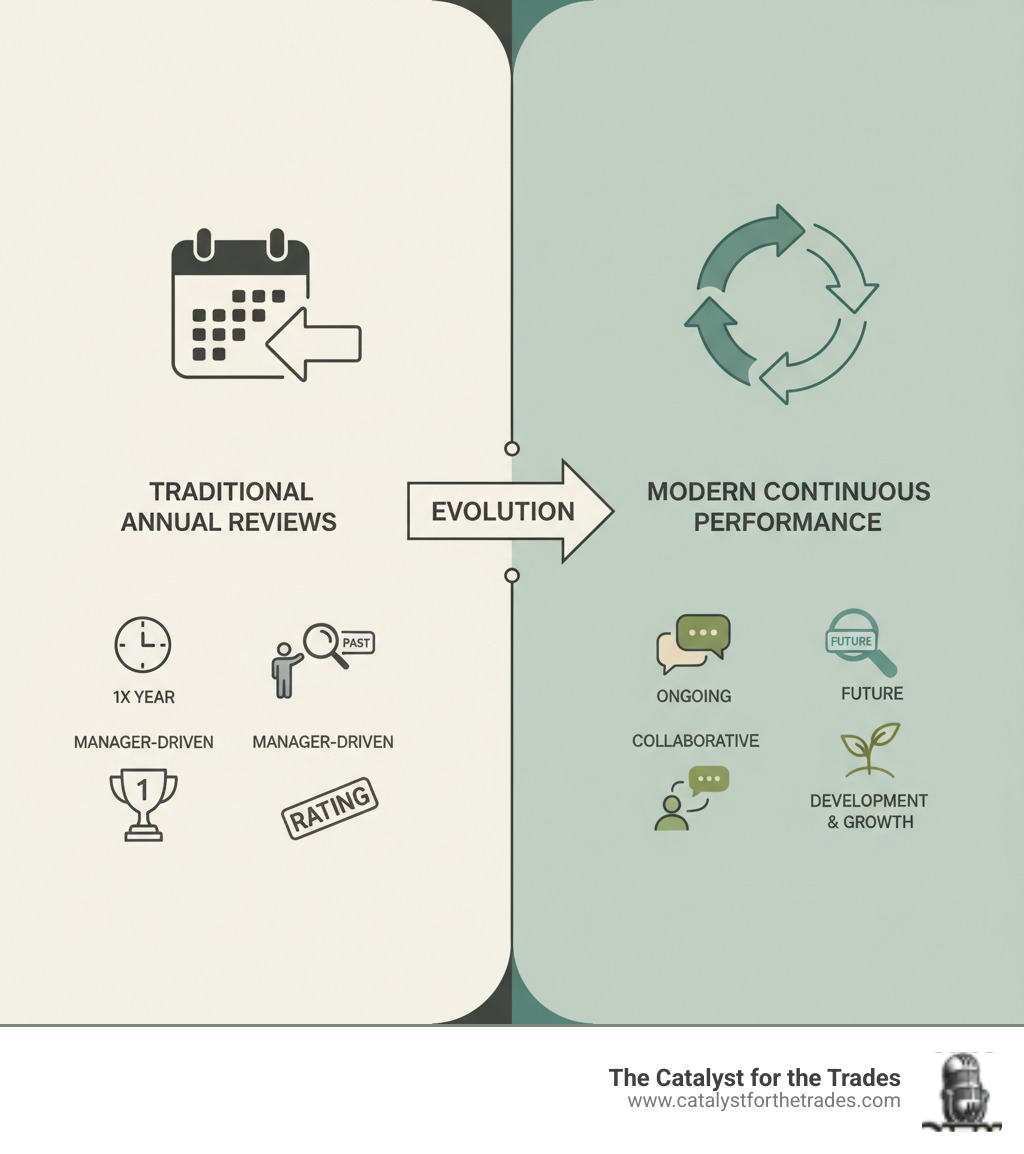Elevate your leadership. Explore top leadership conferences, gain insights, network strategically, and boost your career. Get the ultimate guide!

What is Performance Management? Driving Results and Growth
Why Performance Management Matters for Your Trades Business
Performance management is the continuous process of communication between managers and employees to set clear expectations, provide regular feedback, and align work with company goals. It's not a single annual review, but a year-round cycle of planning, monitoring, developing, and rewarding performance.
- Planning: Set clear, collaborative goals.
- Monitoring: Track progress with ongoing feedback.
- Developing: Coach employees to improve skills.
- Rating & Rewarding: Recognize strong performance.
Many trades businesses struggle here. Research shows 21% of employees say their goals are set annually and never revisited, and 16% set no goals at all. This neglect is a missed opportunity, as companies with effective performance management are 1.5 times more likely to outperform competitors financially and see 1.25 times more employee productivity.
For scaling trades businesses competing for talent, this is a critical advantage. Modern performance management has moved beyond the annual review to a model of continuous coaching and real-time feedback. It's a strategic tool to retain top technicians, boost customer satisfaction, and build a culture that attracts the best.

The Anatomy of a High-Impact Performance Management System
At its core, performance management creates an environment where your team can thrive, aiding retention and productivity. Effective systems follow a continuous four-stage cycle:

- Planning: This is the collaborative starting point where managers and employees set clear goals together. For a new HVAC tech, this could mean setting targets for service call completion rates or customer satisfaction scores that align with business objectives.
- Monitoring: This stage involves continuous check-ins to track progress and provide support without micromanaging. It’s about proactively offering feedback and celebrating wins, ensuring everyone stays on course.
- Developing: Here, you invest in your people's growth through training, coaching, and mentorship. Whether it's helping a lead electrician move into a supervisory role or teaching a new installation technique, development builds your team's capacity and your competitive advantage.
- Rating and Rewarding: This final stage evaluates performance against the goals set during planning. Because of the ongoing monitoring and development, there are no surprises. It’s a time to formally recognize contributions and celebrate successes, reinforcing the behaviors you want to see.
These stages flow into a continuous loop, creating a rhythm of communication and improvement that becomes part of your company culture.
Performance Management vs. Performance Appraisals
Many confuse performance management with performance appraisals, but they are fundamentally different. A performance appraisal is a single, backward-looking event—like a report card. Performance management is an ongoing, forward-looking process focused on development and coaching.
The appraisal is a snapshot; performance management is the entire movie. One is a formal, manager-driven judgment, while the other is a collaborative dialogue. This shift from judging to coaching is key to building a high-performance culture.
| Feature | Performance Management | Performance Appraisal |
|---|---|---|
| Frequency | Ongoing, continuous process throughout the year, with regular check-ins | Typically a single, formal event (annually or bi-annually) |
| Focus | Future-focused, on development, growth, and continuous improvement | Backward-looking, evaluating past performance over a specific period |
| Nature | Dynamic dialogue, coaching, feedback, and collaboration between manager and employee | Formal review, often manager-driven, focused on judgment and documentation |
| Goal | To empower employees, align efforts, improve performance, and foster development | To assess performance, determine compensation, or document for HR records |
| Relationship to Goals | Goals are set collaboratively and reviewed continuously | Goals are assessed at the end of the period to see if they were met |
| Outcome | Improved performance, skill development, increased engagement | Performance rating, salary adjustment, documentation |
Shifting to a learning-centric approach helps your team reach its full potential, driving your business forward.
The Benefits for Your Trades Business
Implementing an effective performance management system delivers tangible results for your trades business. It directly boosts employee engagement by involving technicians in their own goal-setting, making them feel like valued partners. This investment in your people leads to higher retention, as clear career paths and a supportive environment give skilled tradespeople a reason to stay.
This process inherently improves your company culture by fostering transparency and trust. With clear goals and consistent feedback, productivity naturally increases. Companies using effective performance management programs are 1.25 times more likely to see increased employee productivity.
These benefits drive financial results. A motivated, skilled, and efficient team delivers exceptional service, and research shows that organizations with effective performance management practices are 1.5 times as likely to outperform their competitors financially. This isn't an expense; it's an investment in your future.
Implementing Effective Performance Management in Your Shop
Implementing performance management effectively starts with training your managers. They are the foundation of the system, and if they can't coach, give feedback, or set clear expectations, the system will fail. They need practical training on how to lead, not just supervise.
A successful approach in the trades balances both results and behaviors. While hitting a target of five service calls a day is important, how a technician achieves it—through clear communication and safety protocols—matters just as much.
Finally, set clear expectations from day one. A new installer should know what success looks like in their first 30, 60, and 90 days. As Mike Abramowitz notes, systems create freedom, and a clear performance management system allows everyone to focus on growth.
How Systems Create Freedom: Mike Abramowitz's Blueprint for Trades Success
Setting Goals That Drive Performance
Effective goals provide a roadmap for your team. Use the SMART framework to make them Specific, Measurable, Achievable, Relevant, and Time-bound. For example, instead of "do better work," a goal could be "reduce average service call time by 15% while maintaining a 9/10 customer satisfaction score."
Ensure individual goals align with company objectives. A dispatcher's goal to improve call handling should support the company's goal of increasing customer retention.
Crucially, involve your team in setting their goals. A Betterworks study found only 27% of workers feel included in goal setting. When a lead plumber helps set their team's KPIs—like job profit margin or customer callback rates—they gain a sense of ownership.
Finally, treat goals as living documents. Review them regularly to stay focused on what matters now. Frameworks like EOS can provide the structure needed for effective goal setting and tracking.
A Betterworks study on goal setting
From Chaos to Clarity: How EOS Transforms Your Business
Fostering a Culture of Continuous Feedback and Coaching
High-performance teams run on continuous feedback, not annual reviews. Adopt a coaching mindset and make conversations a regular part of your operations.

- Regular Check-ins: Use short, weekly or bi-weekly chats to discuss progress, remove roadblocks, and stay aligned.
- Deeper One-on-Ones: Dedicate time for more structured conversations about career goals and development.
- Real-time Feedback: Address successes and mistakes immediately, when the feedback is most impactful.
Shift your managers' mindset from judge to coach. Instead of pointing out errors, ask questions like, "What could we do differently next time?" to build problem-solving skills. Also, focus on amplifying your team's strengths rather than just correcting weaknesses. A third of employees rarely get feedback; by making it frequent and constructive, you create a significant competitive advantage and a culture where people want to grow.
The Future of Leadership: How to Build a Team That Drives Growth
The Role of Technology and DEI in Modern Performance Management
Two forces are reshaping modern performance management: technology and DEI (diversity, equity, and inclusion).
Technology makes performance tracking a real-time, data-driven process. Integrate performance metrics from your Field Service Management (FSM) tools—like job completion rates and customer satisfaction scores—directly into your conversations. This makes feedback objective and timely, allowing a technician to track goals from their phone.
DEI is critical for fairness and open uping potential. Technology can help reduce the unconscious bias often found in traditional reviews by focusing on objective data. More importantly, a DEI-focused approach ensures equitable processes for growth and promotion. By creating clear, consistent evaluation criteria and inclusive goal-setting practices, you ensure every team member has an equal opportunity to succeed. This is crucial for retaining a diverse and talented workforce.
As remote and hybrid work become more common, adapt your processes to ensure clear communication and accountability for all team members, regardless of their location. Combining technology and DEI creates a fair, efficient, and empowering system for everyone.
How AI, Bold Leadership, and No-Excuse Execution Are Transforming Home Services
Overcoming Common Challenges in Performance Management
Implementing performance management comes with predictable challenges, but each has a solution. Overcoming them is key to building an engaged and productive team.

A common hurdle is a lack of buy-in from managers and technicians. To solve this, clearly communicate how the system benefits them personally with clearer expectations and opportunities for growth. Another killer is inconsistent application, where some managers are engaged and others are not. Standardize your process with consistent training for all managers to ensure fairness.
Many managers also have a fear of difficult conversations. Equip them with coaching skills and frameworks to deliver constructive feedback with empathy, focusing on solutions instead of blame. For the constant complaint of "I don't have time for this," the solution is to integrate performance conversations into existing routines, like a five-minute check-in after a job, and use technology to handle administrative tasks.
Don't forget to adapt for remote and hybrid work by focusing on clear communication and objective-based tracking. Finally, to prevent forgotten goals, build goal reviews into your regular check-in rhythm to keep them relevant and visible.
Here's a quick reference for tackling these challenges:
- Lack of buy-in → Communicate personal benefits and get leadership buy-in.
- Inconsistent application → Standardize training and processes.
- Fear of difficult conversations → Teach coaching skills and practice.
- Time constraints → Integrate into daily routines and use technology.
- Remote/hybrid adaptation → Focus on clear communication and objective tracking.
- Forgotten goals → Review goals during regular check-ins.
Overcoming these obstacles requires commitment, but the payoff in team engagement and business results is well worth the effort.
Frequently Asked Questions about Performance Management
We talk to trades business owners every day, and the same questions keep coming up. If you're wondering about the nuts and bolts of performance management, you're not alone. Let's clear up some of the confusion.
What's the difference between performance management and a performance appraisal?
A performance appraisal is a single event, typically an annual review that looks backward to judge past performance. It's a formal meeting that often feels like a report card.
Performance management, on the other hand, is a continuous, year-round process. It's forward-looking and focuses on development through ongoing coaching, feedback, and goal alignment. The appraisal may be one small part of the system, but performance management is the entire journey of helping your team grow.
How often should performance conversations happen?
Performance conversations should be frequent and ongoing, not just once a year.
- Weekly or Bi-weekly Check-ins: These should be quick, informal pulse checks to discuss progress and roadblocks.
- Monthly One-on-Ones: Schedule more structured time to dive deeper into goals, career development, and feedback.
- Quarterly Reviews: Use these to assess progress on larger goals and adjust as needed.
A third of employees rarely get feedback. Making conversations a regular habit is a simple way to boost engagement and ensure your technicians feel supported and on track.
What are some good performance goals for a field technician?
Good goals for a field technician should be clear, measurable, and tied to business results. Involve your technicians in setting them to ensure buy-in. Here are some practical examples across key areas:
- Customer Satisfaction: "Maintain an average customer rating of 4.8/5.0 on post-service surveys this quarter."
- Efficiency: "Reduce average service call time by 10% by year-end without impacting quality."
- Skill Development: "Complete EPA 608 Universal certification by the end of Q3."
- Revenue Generation: "Increase average ticket size by 15% through effective accessory recommendations over the next six months."
- Safety and Compliance: "Achieve a 100% completion rate on pre-job safety checklists for all jobs."
Regularly review these goals with your technicians, adjust as needed, and celebrate their achievements along the way. That's what real performance management looks like.
Conclusion: Build a Culture That Drives Growth
Performance management is more than an HR task; it's the strategic backbone of a thriving trades business. By shifting from outdated annual reviews to a system of continuous conversation, you build a culture of growth and trust.
This means setting collaborative goals, giving frequent feedback, and training your managers to be coaches. The results are clear: higher employee engagement, better retention, increased productivity, and stronger financial performance. This change requires leadership commitment and consistency, but the investment in your people pays dividends.
At The Catalyst for the Trades, we know that the right systems are essential for scaling. Whether applying EOS principles or leveraging new technology, success comes from empowering your team. Your people are the engine of your business.
Start today. Implement weekly check-ins or collaborative goal-setting. Build a culture where your team feels valued and has the support to excel. That is how you build a business that doesn't just grow—it thrives.
Why Performance Management Matters for Your Trades Business
Performance management is the continuous process of communication between managers and employees to set clear expectations, provide regular feedback, and align work with company goals. It's not a single annual review, but a year-round cycle of planning, monitoring, developing, and rewarding performance.
- Planning: Set clear, collaborative goals.
- Monitoring: Track progress with ongoing feedback.
- Developing: Coach employees to improve skills.
- Rating & Rewarding: Recognize strong performance.
Many trades businesses struggle here. Research shows 21% of employees say their goals are set annually and never revisited, and 16% set no goals at all. This neglect is a missed opportunity, as companies with effective performance management are 1.5 times more likely to outperform competitors financially and see 1.25 times more employee productivity.
For scaling trades businesses competing for talent, this is a critical advantage. Modern performance management has moved beyond the annual review to a model of continuous coaching and real-time feedback. It's a strategic tool to retain top technicians, boost customer satisfaction, and build a culture that attracts the best.

The Anatomy of a High-Impact Performance Management System
At its core, performance management creates an environment where your team can thrive, aiding retention and productivity. Effective systems follow a continuous four-stage cycle:

- Planning: This is the collaborative starting point where managers and employees set clear goals together. For a new HVAC tech, this could mean setting targets for service call completion rates or customer satisfaction scores that align with business objectives.
- Monitoring: This stage involves continuous check-ins to track progress and provide support without micromanaging. It’s about proactively offering feedback and celebrating wins, ensuring everyone stays on course.
- Developing: Here, you invest in your people's growth through training, coaching, and mentorship. Whether it's helping a lead electrician move into a supervisory role or teaching a new installation technique, development builds your team's capacity and your competitive advantage.
- Rating and Rewarding: This final stage evaluates performance against the goals set during planning. Because of the ongoing monitoring and development, there are no surprises. It’s a time to formally recognize contributions and celebrate successes, reinforcing the behaviors you want to see.
These stages flow into a continuous loop, creating a rhythm of communication and improvement that becomes part of your company culture.
Performance Management vs. Performance Appraisals
Many confuse performance management with performance appraisals, but they are fundamentally different. A performance appraisal is a single, backward-looking event—like a report card. Performance management is an ongoing, forward-looking process focused on development and coaching.
The appraisal is a snapshot; performance management is the entire movie. One is a formal, manager-driven judgment, while the other is a collaborative dialogue. This shift from judging to coaching is key to building a high-performance culture.
| Feature | Performance Management | Performance Appraisal |
|---|---|---|
| Frequency | Ongoing, continuous process throughout the year, with regular check-ins | Typically a single, formal event (annually or bi-annually) |
| Focus | Future-focused, on development, growth, and continuous improvement | Backward-looking, evaluating past performance over a specific period |
| Nature | Dynamic dialogue, coaching, feedback, and collaboration between manager and employee | Formal review, often manager-driven, focused on judgment and documentation |
| Goal | To empower employees, align efforts, improve performance, and foster development | To assess performance, determine compensation, or document for HR records |
| Relationship to Goals | Goals are set collaboratively and reviewed continuously | Goals are assessed at the end of the period to see if they were met |
| Outcome | Improved performance, skill development, increased engagement | Performance rating, salary adjustment, documentation |
Shifting to a learning-centric approach helps your team reach its full potential, driving your business forward.
The Benefits for Your Trades Business
Implementing an effective performance management system delivers tangible results for your trades business. It directly boosts employee engagement by involving technicians in their own goal-setting, making them feel like valued partners. This investment in your people leads to higher retention, as clear career paths and a supportive environment give skilled tradespeople a reason to stay.
This process inherently improves your company culture by fostering transparency and trust. With clear goals and consistent feedback, productivity naturally increases. Companies using effective performance management programs are 1.25 times more likely to see increased employee productivity.
These benefits drive financial results. A motivated, skilled, and efficient team delivers exceptional service, and research shows that organizations with effective performance management practices are 1.5 times as likely to outperform their competitors financially. This isn't an expense; it's an investment in your future.
Implementing Effective Performance Management in Your Shop
Implementing performance management effectively starts with training your managers. They are the foundation of the system, and if they can't coach, give feedback, or set clear expectations, the system will fail. They need practical training on how to lead, not just supervise.
A successful approach in the trades balances both results and behaviors. While hitting a target of five service calls a day is important, how a technician achieves it—through clear communication and safety protocols—matters just as much.
Finally, set clear expectations from day one. A new installer should know what success looks like in their first 30, 60, and 90 days. As Mike Abramowitz notes, systems create freedom, and a clear performance management system allows everyone to focus on growth.
How Systems Create Freedom: Mike Abramowitz's Blueprint for Trades Success
Setting Goals That Drive Performance
Effective goals provide a roadmap for your team. Use the SMART framework to make them Specific, Measurable, Achievable, Relevant, and Time-bound. For example, instead of "do better work," a goal could be "reduce average service call time by 15% while maintaining a 9/10 customer satisfaction score."
Ensure individual goals align with company objectives. A dispatcher's goal to improve call handling should support the company's goal of increasing customer retention.
Crucially, involve your team in setting their goals. A Betterworks study found only 27% of workers feel included in goal setting. When a lead plumber helps set their team's KPIs—like job profit margin or customer callback rates—they gain a sense of ownership.
Finally, treat goals as living documents. Review them regularly to stay focused on what matters now. Frameworks like EOS can provide the structure needed for effective goal setting and tracking.
A Betterworks study on goal setting
From Chaos to Clarity: How EOS Transforms Your Business
Fostering a Culture of Continuous Feedback and Coaching
High-performance teams run on continuous feedback, not annual reviews. Adopt a coaching mindset and make conversations a regular part of your operations.

- Regular Check-ins: Use short, weekly or bi-weekly chats to discuss progress, remove roadblocks, and stay aligned.
- Deeper One-on-Ones: Dedicate time for more structured conversations about career goals and development.
- Real-time Feedback: Address successes and mistakes immediately, when the feedback is most impactful.
Shift your managers' mindset from judge to coach. Instead of pointing out errors, ask questions like, "What could we do differently next time?" to build problem-solving skills. Also, focus on amplifying your team's strengths rather than just correcting weaknesses. A third of employees rarely get feedback; by making it frequent and constructive, you create a significant competitive advantage and a culture where people want to grow.
The Future of Leadership: How to Build a Team That Drives Growth
The Role of Technology and DEI in Modern Performance Management
Two forces are reshaping modern performance management: technology and DEI (diversity, equity, and inclusion).
Technology makes performance tracking a real-time, data-driven process. Integrate performance metrics from your Field Service Management (FSM) tools—like job completion rates and customer satisfaction scores—directly into your conversations. This makes feedback objective and timely, allowing a technician to track goals from their phone.
DEI is critical for fairness and open uping potential. Technology can help reduce the unconscious bias often found in traditional reviews by focusing on objective data. More importantly, a DEI-focused approach ensures equitable processes for growth and promotion. By creating clear, consistent evaluation criteria and inclusive goal-setting practices, you ensure every team member has an equal opportunity to succeed. This is crucial for retaining a diverse and talented workforce.
As remote and hybrid work become more common, adapt your processes to ensure clear communication and accountability for all team members, regardless of their location. Combining technology and DEI creates a fair, efficient, and empowering system for everyone.
How AI, Bold Leadership, and No-Excuse Execution Are Transforming Home Services
Overcoming Common Challenges in Performance Management
Implementing performance management comes with predictable challenges, but each has a solution. Overcoming them is key to building an engaged and productive team.

A common hurdle is a lack of buy-in from managers and technicians. To solve this, clearly communicate how the system benefits them personally with clearer expectations and opportunities for growth. Another killer is inconsistent application, where some managers are engaged and others are not. Standardize your process with consistent training for all managers to ensure fairness.
Many managers also have a fear of difficult conversations. Equip them with coaching skills and frameworks to deliver constructive feedback with empathy, focusing on solutions instead of blame. For the constant complaint of "I don't have time for this," the solution is to integrate performance conversations into existing routines, like a five-minute check-in after a job, and use technology to handle administrative tasks.
Don't forget to adapt for remote and hybrid work by focusing on clear communication and objective-based tracking. Finally, to prevent forgotten goals, build goal reviews into your regular check-in rhythm to keep them relevant and visible.
Here's a quick reference for tackling these challenges:
- Lack of buy-in → Communicate personal benefits and get leadership buy-in.
- Inconsistent application → Standardize training and processes.
- Fear of difficult conversations → Teach coaching skills and practice.
- Time constraints → Integrate into daily routines and use technology.
- Remote/hybrid adaptation → Focus on clear communication and objective tracking.
- Forgotten goals → Review goals during regular check-ins.
Overcoming these obstacles requires commitment, but the payoff in team engagement and business results is well worth the effort.
Frequently Asked Questions about Performance Management
We talk to trades business owners every day, and the same questions keep coming up. If you're wondering about the nuts and bolts of performance management, you're not alone. Let's clear up some of the confusion.
What's the difference between performance management and a performance appraisal?
A performance appraisal is a single event, typically an annual review that looks backward to judge past performance. It's a formal meeting that often feels like a report card.
Performance management, on the other hand, is a continuous, year-round process. It's forward-looking and focuses on development through ongoing coaching, feedback, and goal alignment. The appraisal may be one small part of the system, but performance management is the entire journey of helping your team grow.
How often should performance conversations happen?
Performance conversations should be frequent and ongoing, not just once a year.
- Weekly or Bi-weekly Check-ins: These should be quick, informal pulse checks to discuss progress and roadblocks.
- Monthly One-on-Ones: Schedule more structured time to dive deeper into goals, career development, and feedback.
- Quarterly Reviews: Use these to assess progress on larger goals and adjust as needed.
A third of employees rarely get feedback. Making conversations a regular habit is a simple way to boost engagement and ensure your technicians feel supported and on track.
What are some good performance goals for a field technician?
Good goals for a field technician should be clear, measurable, and tied to business results. Involve your technicians in setting them to ensure buy-in. Here are some practical examples across key areas:
- Customer Satisfaction: "Maintain an average customer rating of 4.8/5.0 on post-service surveys this quarter."
- Efficiency: "Reduce average service call time by 10% by year-end without impacting quality."
- Skill Development: "Complete EPA 608 Universal certification by the end of Q3."
- Revenue Generation: "Increase average ticket size by 15% through effective accessory recommendations over the next six months."
- Safety and Compliance: "Achieve a 100% completion rate on pre-job safety checklists for all jobs."
Regularly review these goals with your technicians, adjust as needed, and celebrate their achievements along the way. That's what real performance management looks like.
Conclusion: Build a Culture That Drives Growth
Performance management is more than an HR task; it's the strategic backbone of a thriving trades business. By shifting from outdated annual reviews to a system of continuous conversation, you build a culture of growth and trust.
This means setting collaborative goals, giving frequent feedback, and training your managers to be coaches. The results are clear: higher employee engagement, better retention, increased productivity, and stronger financial performance. This change requires leadership commitment and consistency, but the investment in your people pays dividends.
At The Catalyst for the Trades, we know that the right systems are essential for scaling. Whether applying EOS principles or leveraging new technology, success comes from empowering your team. Your people are the engine of your business.
Start today. Implement weekly check-ins or collaborative goal-setting. Build a culture where your team feels valued and has the support to excel. That is how you build a business that doesn't just grow—it thrives.
Why Performance Management Matters for Your Trades Business
Performance management is the continuous process of communication between managers and employees to set clear expectations, provide regular feedback, and align work with company goals. It's not a single annual review, but a year-round cycle of planning, monitoring, developing, and rewarding performance.
- Planning: Set clear, collaborative goals.
- Monitoring: Track progress with ongoing feedback.
- Developing: Coach employees to improve skills.
- Rating & Rewarding: Recognize strong performance.
Many trades businesses struggle here. Research shows 21% of employees say their goals are set annually and never revisited, and 16% set no goals at all. This neglect is a missed opportunity, as companies with effective performance management are 1.5 times more likely to outperform competitors financially and see 1.25 times more employee productivity.
For scaling trades businesses competing for talent, this is a critical advantage. Modern performance management has moved beyond the annual review to a model of continuous coaching and real-time feedback. It's a strategic tool to retain top technicians, boost customer satisfaction, and build a culture that attracts the best.

The Anatomy of a High-Impact Performance Management System
At its core, performance management creates an environment where your team can thrive, aiding retention and productivity. Effective systems follow a continuous four-stage cycle:

- Planning: This is the collaborative starting point where managers and employees set clear goals together. For a new HVAC tech, this could mean setting targets for service call completion rates or customer satisfaction scores that align with business objectives.
- Monitoring: This stage involves continuous check-ins to track progress and provide support without micromanaging. It’s about proactively offering feedback and celebrating wins, ensuring everyone stays on course.
- Developing: Here, you invest in your people's growth through training, coaching, and mentorship. Whether it's helping a lead electrician move into a supervisory role or teaching a new installation technique, development builds your team's capacity and your competitive advantage.
- Rating and Rewarding: This final stage evaluates performance against the goals set during planning. Because of the ongoing monitoring and development, there are no surprises. It’s a time to formally recognize contributions and celebrate successes, reinforcing the behaviors you want to see.
These stages flow into a continuous loop, creating a rhythm of communication and improvement that becomes part of your company culture.
Performance Management vs. Performance Appraisals
Many confuse performance management with performance appraisals, but they are fundamentally different. A performance appraisal is a single, backward-looking event—like a report card. Performance management is an ongoing, forward-looking process focused on development and coaching.
The appraisal is a snapshot; performance management is the entire movie. One is a formal, manager-driven judgment, while the other is a collaborative dialogue. This shift from judging to coaching is key to building a high-performance culture.
| Feature | Performance Management | Performance Appraisal |
|---|---|---|
| Frequency | Ongoing, continuous process throughout the year, with regular check-ins | Typically a single, formal event (annually or bi-annually) |
| Focus | Future-focused, on development, growth, and continuous improvement | Backward-looking, evaluating past performance over a specific period |
| Nature | Dynamic dialogue, coaching, feedback, and collaboration between manager and employee | Formal review, often manager-driven, focused on judgment and documentation |
| Goal | To empower employees, align efforts, improve performance, and foster development | To assess performance, determine compensation, or document for HR records |
| Relationship to Goals | Goals are set collaboratively and reviewed continuously | Goals are assessed at the end of the period to see if they were met |
| Outcome | Improved performance, skill development, increased engagement | Performance rating, salary adjustment, documentation |
Shifting to a learning-centric approach helps your team reach its full potential, driving your business forward.
The Benefits for Your Trades Business
Implementing an effective performance management system delivers tangible results for your trades business. It directly boosts employee engagement by involving technicians in their own goal-setting, making them feel like valued partners. This investment in your people leads to higher retention, as clear career paths and a supportive environment give skilled tradespeople a reason to stay.
This process inherently improves your company culture by fostering transparency and trust. With clear goals and consistent feedback, productivity naturally increases. Companies using effective performance management programs are 1.25 times more likely to see increased employee productivity.
These benefits drive financial results. A motivated, skilled, and efficient team delivers exceptional service, and research shows that organizations with effective performance management practices are 1.5 times as likely to outperform their competitors financially. This isn't an expense; it's an investment in your future.
Implementing Effective Performance Management in Your Shop
Implementing performance management effectively starts with training your managers. They are the foundation of the system, and if they can't coach, give feedback, or set clear expectations, the system will fail. They need practical training on how to lead, not just supervise.
A successful approach in the trades balances both results and behaviors. While hitting a target of five service calls a day is important, how a technician achieves it—through clear communication and safety protocols—matters just as much.
Finally, set clear expectations from day one. A new installer should know what success looks like in their first 30, 60, and 90 days. As Mike Abramowitz notes, systems create freedom, and a clear performance management system allows everyone to focus on growth.
How Systems Create Freedom: Mike Abramowitz's Blueprint for Trades Success
Setting Goals That Drive Performance
Effective goals provide a roadmap for your team. Use the SMART framework to make them Specific, Measurable, Achievable, Relevant, and Time-bound. For example, instead of "do better work," a goal could be "reduce average service call time by 15% while maintaining a 9/10 customer satisfaction score."
Ensure individual goals align with company objectives. A dispatcher's goal to improve call handling should support the company's goal of increasing customer retention.
Crucially, involve your team in setting their goals. A Betterworks study found only 27% of workers feel included in goal setting. When a lead plumber helps set their team's KPIs—like job profit margin or customer callback rates—they gain a sense of ownership.
Finally, treat goals as living documents. Review them regularly to stay focused on what matters now. Frameworks like EOS can provide the structure needed for effective goal setting and tracking.
A Betterworks study on goal setting
From Chaos to Clarity: How EOS Transforms Your Business
Fostering a Culture of Continuous Feedback and Coaching
High-performance teams run on continuous feedback, not annual reviews. Adopt a coaching mindset and make conversations a regular part of your operations.

- Regular Check-ins: Use short, weekly or bi-weekly chats to discuss progress, remove roadblocks, and stay aligned.
- Deeper One-on-Ones: Dedicate time for more structured conversations about career goals and development.
- Real-time Feedback: Address successes and mistakes immediately, when the feedback is most impactful.
Shift your managers' mindset from judge to coach. Instead of pointing out errors, ask questions like, "What could we do differently next time?" to build problem-solving skills. Also, focus on amplifying your team's strengths rather than just correcting weaknesses. A third of employees rarely get feedback; by making it frequent and constructive, you create a significant competitive advantage and a culture where people want to grow.
The Future of Leadership: How to Build a Team That Drives Growth
The Role of Technology and DEI in Modern Performance Management
Two forces are reshaping modern performance management: technology and DEI (diversity, equity, and inclusion).
Technology makes performance tracking a real-time, data-driven process. Integrate performance metrics from your Field Service Management (FSM) tools—like job completion rates and customer satisfaction scores—directly into your conversations. This makes feedback objective and timely, allowing a technician to track goals from their phone.
DEI is critical for fairness and open uping potential. Technology can help reduce the unconscious bias often found in traditional reviews by focusing on objective data. More importantly, a DEI-focused approach ensures equitable processes for growth and promotion. By creating clear, consistent evaluation criteria and inclusive goal-setting practices, you ensure every team member has an equal opportunity to succeed. This is crucial for retaining a diverse and talented workforce.
As remote and hybrid work become more common, adapt your processes to ensure clear communication and accountability for all team members, regardless of their location. Combining technology and DEI creates a fair, efficient, and empowering system for everyone.
How AI, Bold Leadership, and No-Excuse Execution Are Transforming Home Services
Overcoming Common Challenges in Performance Management
Implementing performance management comes with predictable challenges, but each has a solution. Overcoming them is key to building an engaged and productive team.

A common hurdle is a lack of buy-in from managers and technicians. To solve this, clearly communicate how the system benefits them personally with clearer expectations and opportunities for growth. Another killer is inconsistent application, where some managers are engaged and others are not. Standardize your process with consistent training for all managers to ensure fairness.
Many managers also have a fear of difficult conversations. Equip them with coaching skills and frameworks to deliver constructive feedback with empathy, focusing on solutions instead of blame. For the constant complaint of "I don't have time for this," the solution is to integrate performance conversations into existing routines, like a five-minute check-in after a job, and use technology to handle administrative tasks.
Don't forget to adapt for remote and hybrid work by focusing on clear communication and objective-based tracking. Finally, to prevent forgotten goals, build goal reviews into your regular check-in rhythm to keep them relevant and visible.
Here's a quick reference for tackling these challenges:
- Lack of buy-in → Communicate personal benefits and get leadership buy-in.
- Inconsistent application → Standardize training and processes.
- Fear of difficult conversations → Teach coaching skills and practice.
- Time constraints → Integrate into daily routines and use technology.
- Remote/hybrid adaptation → Focus on clear communication and objective tracking.
- Forgotten goals → Review goals during regular check-ins.
Overcoming these obstacles requires commitment, but the payoff in team engagement and business results is well worth the effort.
Frequently Asked Questions about Performance Management
We talk to trades business owners every day, and the same questions keep coming up. If you're wondering about the nuts and bolts of performance management, you're not alone. Let's clear up some of the confusion.
What's the difference between performance management and a performance appraisal?
A performance appraisal is a single event, typically an annual review that looks backward to judge past performance. It's a formal meeting that often feels like a report card.
Performance management, on the other hand, is a continuous, year-round process. It's forward-looking and focuses on development through ongoing coaching, feedback, and goal alignment. The appraisal may be one small part of the system, but performance management is the entire journey of helping your team grow.
How often should performance conversations happen?
Performance conversations should be frequent and ongoing, not just once a year.
- Weekly or Bi-weekly Check-ins: These should be quick, informal pulse checks to discuss progress and roadblocks.
- Monthly One-on-Ones: Schedule more structured time to dive deeper into goals, career development, and feedback.
- Quarterly Reviews: Use these to assess progress on larger goals and adjust as needed.
A third of employees rarely get feedback. Making conversations a regular habit is a simple way to boost engagement and ensure your technicians feel supported and on track.
What are some good performance goals for a field technician?
Good goals for a field technician should be clear, measurable, and tied to business results. Involve your technicians in setting them to ensure buy-in. Here are some practical examples across key areas:
- Customer Satisfaction: "Maintain an average customer rating of 4.8/5.0 on post-service surveys this quarter."
- Efficiency: "Reduce average service call time by 10% by year-end without impacting quality."
- Skill Development: "Complete EPA 608 Universal certification by the end of Q3."
- Revenue Generation: "Increase average ticket size by 15% through effective accessory recommendations over the next six months."
- Safety and Compliance: "Achieve a 100% completion rate on pre-job safety checklists for all jobs."
Regularly review these goals with your technicians, adjust as needed, and celebrate their achievements along the way. That's what real performance management looks like.
Conclusion: Build a Culture That Drives Growth
Performance management is more than an HR task; it's the strategic backbone of a thriving trades business. By shifting from outdated annual reviews to a system of continuous conversation, you build a culture of growth and trust.
This means setting collaborative goals, giving frequent feedback, and training your managers to be coaches. The results are clear: higher employee engagement, better retention, increased productivity, and stronger financial performance. This change requires leadership commitment and consistency, but the investment in your people pays dividends.
At The Catalyst for the Trades, we know that the right systems are essential for scaling. Whether applying EOS principles or leveraging new technology, success comes from empowering your team. Your people are the engine of your business.
Start today. Implement weekly check-ins or collaborative goal-setting. Build a culture where your team feels valued and has the support to excel. That is how you build a business that doesn't just grow—it thrives.

Discover how leading home‑service companies are leveraging AI, subscription models, and digital‑first strategies.
Learn why private equity, automation, and customer‑centric tech are reshaping the trades.
Episodes you may like


Master business strategy development. Chart your course to growth, competitive advantage & profitability with our expert guide.

Unlock massive home service business growth! Leverage AI, build your team, and master customer experience for your thriving empire.
.png)



